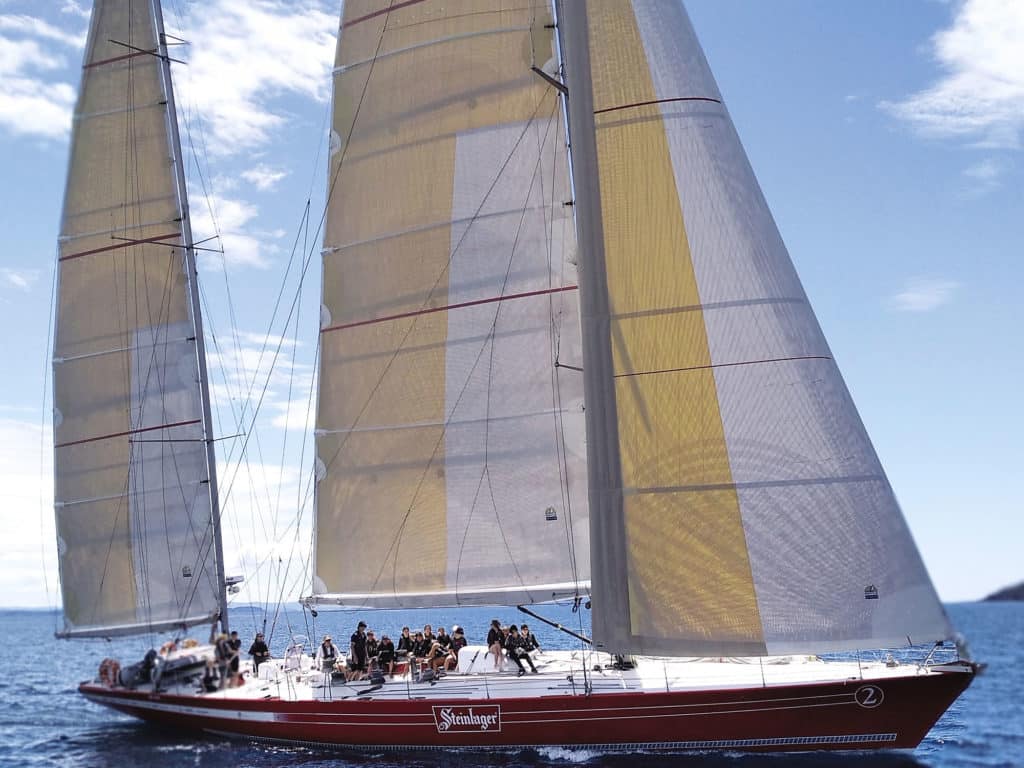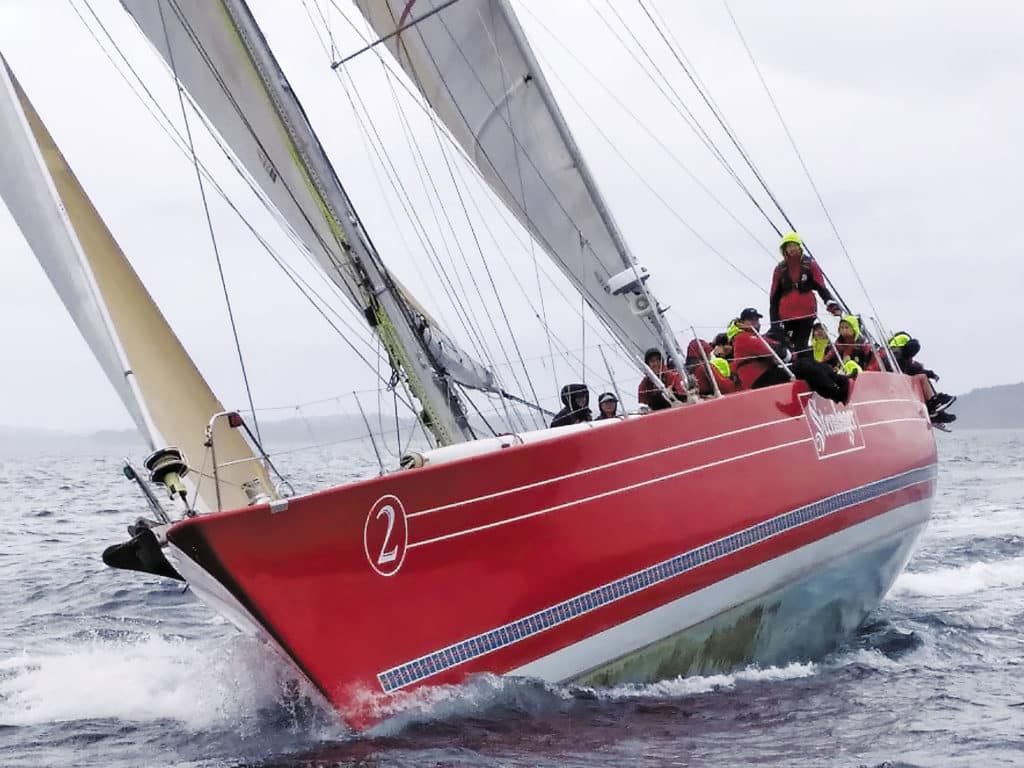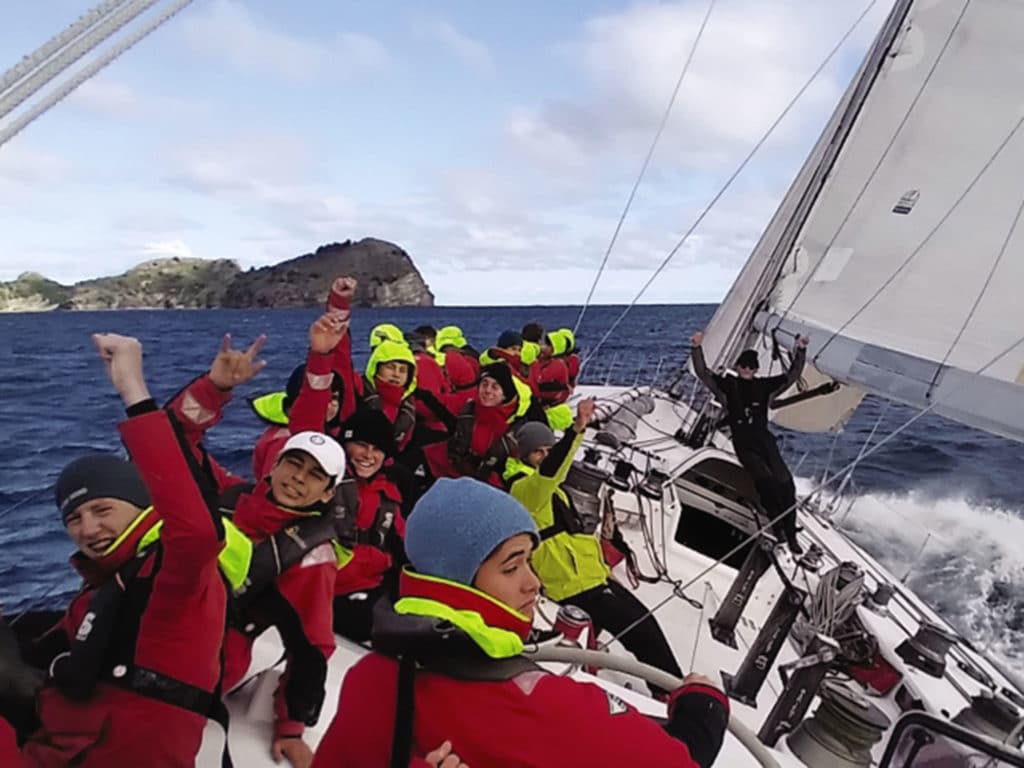
There is a pub in Coromandel, once a gold-mining town and about a day’s sail from Auckland, where beer can still be ordered in 4-pint “jugs.” For years, Kiwi sailors have cruised the Hauraki Gulf, taken the tide up to the wharf, and strolled up the road for a beer at the Star and Garter. In 1992—a time when foils were a thing used in the sport of fencing—Cruising World organized a flotilla here. Writers Herb McCormick and Tim Murphy came to scout out the territory, and it fell to me to sail them around and show off our backyard.
I’ve been thinking about that cruise and a certain noisy evening in the pub. This was back in the day when New Zealand was still a cheeky, but so far unsuccessful, challenger for the America’s Cup. There was growing support for another crack at winning the Old Mug. A local sailor, Peter Blake, had just been tasked with heading up the next Kiwi challenge, scheduled for 1995 in San Diego.
Back then, not many sailors outside the country would have known what Blake had already achieved. This was the Whitbread era, when any well-found yacht with a capable crew could enter the race around the world with a chance of winning on handicap. It may well have been the reputation that New Zealand sailors and boats were gaining around the world that prompted Cruising World to visit. Or maybe it was the epic 1989-90 match race around the world between Kiwi ketches Steinlager 2, skippered by Blake, and Fisher & Paykel, skippered by Grant Dalton. After all, the Hauraki Gulf is where these guys had learned to sail, so there must be something in the waters.
More recently, the Hauraki Gulf was featured on screens around the world as the backdrop to the 75-foot flying-skiff show. On race days in Auckland, the post-match parties continued into the night around the America’s Cup bases at the Viaduct Harbour. Moored in the same basin is Steinlager 2, or “Big Red,” as she is affectionately known. People still talk about how Steinlager 2 and Fisher & Paykel crossed the line in Auckland within three minutes of each other—and days ahead of the bulk of the fleet. By the time they had completed the 32,000-mile race in England, Steinlager 2 had won every leg, a record that has yet to be beaten. Arguably, it was the peak of the maxi-yacht ocean-racing era.
Following the race, her skipper vowed never to venture into the Southern Ocean again. “Big Red” was sold and spent several years campaigning successfully on the US East Coast and in the Mediterranean. Blake, having summited his Everest, was then persuaded to head up Team New Zealand’s challenge for the 1995 America’s Cup. The result was a Kiwi romp that finally knocked Dennis Conner off his perch and gained Blake a knighthood. He went on to manage the successful defense of the Cup in 2000 before retiring from competitive sailing and turning to environmental work, raising awareness of climate change with his Blake Expeditions. Tragically, only a year later, pirates murdered him on the Amazon River.
Steinlager 2, though, carries on. Get up early, and you are likely to see this boat out in the Hauraki Gulf, with students on deck getting her ready for sea. Steinlager 2 is still working hard alongside another Kiwi classic maxi, Lion New Zealand, aka “The Urban Assault Vehicle.” It’s another Whitbread veteran built for Blake, who wanted a vessel that was bulletproof.
Back in 2006, Steinlager 2 was on the market. A charitable trust had been formed in New Zealand to bring the boat back home and get it back to original trim. The plan was to use it for youth training. Steinlager 2 relaunched in 2008 in the original bold-red livery and with a sail wardrobe matching the cloth of racing days. The deck layout remained unchanged. Down below, the layout was modified to accommodate 30 students and four crew. Since then, year-round, the boat has been taking school groups, maritime students and adults to sea.

A few tides have flowed through the Gulf since that Cruising World charter, and I find myself at the wheel of Steinlager 2 as we head out of Viaduct Harbour, past Team New Zealand’s home base and workmen dismantling the Prada boat shed, down the Waitemat Harbour, and across the recent America’s Cup racecourse. On deck are 28 students, many of whom have never been aboard a boat before. We turn upwind, and unfamiliar hands take the handles at the grinding pedestals. Some 2,500 square feet of buff-colored Kevlar climbs hesitantly to the sky, the runner is ground in, and we slowly bear away. The main sheet moans as it is eased around its massive drum. We heel just a little, and the call is for the students to take up positions on the weather rail. The jib is rolled out, the power comes on, the heel increases, and the log climbs effortlessly to 10 knots.
“Big Red” is coming alive. The running lines begin to hum. I hand over the helm to a nervous young student who has grown up on a farm. “You see that island over the bow?” I ask. “Well, head for that.”
The thrill for both of us at that moment cannot be measured. This is my day job. Pinch me.
Typically, on a four- or five-day cruise, Steinlager 2 and Lion will sail in the relatively sheltered waters of the Hauraki Gulf or stretch their legs on a passage up the North Island’s Pacific coast. Among the special anchorages is Tiritiri Matangi, a sanctuary island where native birds thrive predator-free, and where little blue penguins come ashore to roost.

A full day’s sail from Auckland will take us to Great Barrier Island, whose small population enjoys a more relaxed attitude about life than on the mainland. Or we might sail to the Mercury Islands, near where Capt. James Cook set up his instruments in 1769 to observe the planet’s transit. Historic Kawau Island and Coromandel Harbour provide further safe anchorages.
In practice, many of the same haunts that the Cruising World flotilla of 1992 visited are still among the favorite haunts of sailors today. We have a great backyard here in New Zealand. After a week at sea, the students hopefully can tie a knot or two, work up a passage plan, and know a sheet from a halyard.
Certainly, they have had a unique experience. It is not always plain sailing; the program does not stop in foul weather (after all, these boats were built to sail the Southern Ocean). But at the end of a voyage, to feel the growth of the students and see the grins on their faces when they step ashore makes our job well worthwhile.
We are sure that Sir Peter Blake would approve.
Photographer and professional skipper Charles Scoones lives in New Zealand, where he’s involved with America’s Cup course management and youth training on the water. His thirst for adventure led him to sail an open boat to Scandinavia and cross the Atlantic on the US-flagged Spirit of San Francisco in 1969. For more information on the New Zealand Sailing Trust, visit nzsailingtrust.com.








